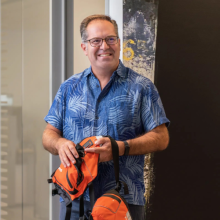
William (Bill) Bruin, is a proud alum of UCSD (Warren' 93), a registered Professional Engineer in six states, and an ACOPNE Board Certified Port Engineer, boasts twenty-eight years of experience in risk consulting, marine and port engineering, and project management. He has successfully applied his expertise to various industrial and waterfront projects.
Mr. Bruin's career has focused on condition assessment, response evaluation, risk identification, hazard mitigation, due-diligence assessment, asset management, and design. His responsibilities have included on-site reviews, condition assessments, analytical evaluations, risk and loss estimations, conceptual upgrade and mitigation designs, rehabilitation, construction document development, permitting support, and on-site supervision of design installations for various onshore, nearshore, and offshore structures and facilities.
Mr. Bruin has received the degrees of Bachelor of Science in Structural Engineering from the University of California San Diego (UCSD) and Master of Science in Civil Engineering from Lehigh University.
Beyond his technical skills, Mr. Bruin has actively participated in disaster response and recovery efforts. He served on two earthquake reconnaissance teams, traveling to disaster-stricken locations in Haiti (2010) with EERI and for the World Bank, and in Japan (2011) with ASCE-COPRI to investigate the performance of marine and waterfront facilities. He also assessed marine oil terminal sites impacted by tsunamis and earthquakes in Chile (2010).
Mr. Bruin has contributed significantly to the engineering field as an active member of prestigious committees, including the ASCE-COPRI Ports and Harbors Committee (Honorary Member), the ASCE 61 Standards Committee (Seismic Design of Piers and Wharves), and the new ASCE Standards Committee for the design of new piers and wharves. He has also authored content for the ASCE-COPRI Manual of Practice for Waterfront Facility Inspection and Assessment (MOP 130). He serves on a subcommittee dedicated to developing the new ASCE-COPRI Manual of Practice for the Rehabilitation of Waterfront and Marine Structures.
Mr. Bruin previously chaired the Organizing Task Committee for the ASCE-COPRI PORTS 2022 conference held in Honolulu, Hawai'i, reflecting his commitment to promoting knowledge sharing and professional development within the engineering community.
Nearshore and waterfront structures exist within the nuanced realm that combines building and bridge design elements, presenting distinctive challenges in their design, construction, and maintenance. These singular structures, exposed to the most severe environmental conditions, necessitate resilience against substantial loads and conditions induced by wind, waves, currents, earthquakes, and tsunamis. Moreover, they bear significant service and operational loads from activities such as container crane operations, heavy lift equipment usage, cargo storage, and the berthing and mooring forces exerted by barges and ships.
The imperative for periodic inspections and condition assessments cannot be overstated for waterfront structures, as they play a pivotal role in upholding the structural integrity of these facilities and maintaining fitness-of-purpose. Such assessments are crucial for averting potential loss of functionality or structural failure caused by damage and deterioration. This presentation will delve into the fundamental aspects of waterfront facility inspections from a marine civil engineer's perspective, shedding light on the essential practices necessary for these vital structures' continued safety and robustness.
